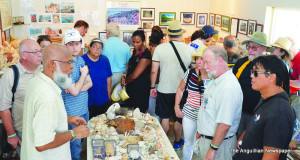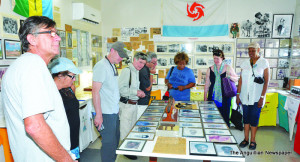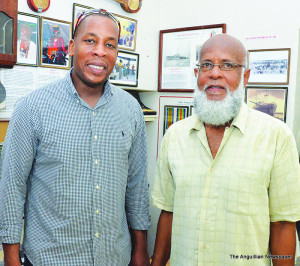
Anguilla welcomed almost one hundred delegates holding membership in the International Association of Caribbean Archaeologists (IACA), who selected the island for a field expedition on Saturday, July 25. They had been attending their 26th Congress at the Sonesta Maho Beach Resort in St. Maarten and came across to Anguilla for the day. They were welcomed by the Ministry of Tourism in collaboration with the Anguilla Tourist Board.
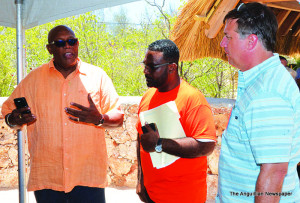
According to Dr. Jay Harviser, President of IACA and Chairman of the Congress Organising Committee, “the theme of the 2015 congress was ‘Unity in Diversity’. This was reflected not only in the congress logo, but also in the functional collaboration between the Governments of St. Maarten, St. Martin and Anguilla in hosting the congress and field expeditions.”
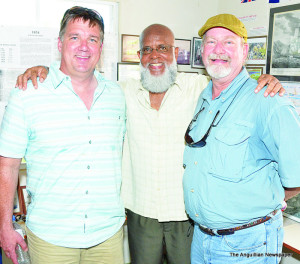
During the conference some 115 papers were presented on a wide range of archaeological-related topics. They included two presentations on Anguilla by Dr. John Crock, of the University of Vermont, who has studied the Amerindian presence in Anguilla for over 20 years and has published extensively on the subject.
Dr. Crock led the archaeologists on the Anguilla field trip, supported by a colleague, Dr. David Waters. The expedition included stops at the Rendezvous Bay archaeological site, Heritage Collection Museum at East End, where the Curator is Mr. Colville L. Petty, and the Amerindian Interpretation Centre and Trail at the Fountain Cavern.
The museum gave the archaeologists an opportunity to better understand the heritage background of the people of Anguilla through the varied artifacts on display. They crowded at intervals into the rooms of the museum and were astonished by the huge collection of artifacts, including a mass of exhibits in the archaeological section. On entering the museum, Dr. Crock told his colleagues in part:
“This is where all the people visiting Anguilla go to see great valuable artifacts stored by Mr Petty who is a noted historian and author. He has generously agreed to allow us to come in on a Saturday when he otherwise might have being done something different. I want to thank him for inviting and welcoming us here.”
Dr. Crock told The Anguillian: “Out of this visit we hope to share, with the delegates of the International Association of Archaeologists, Anguilla’s history. These people care about heritage tourism; the effect of development on history and archaeological sites; the effect of rising sea levels and storms on cultural resources like archaeological sites. Together, we hope to raise awareness and contribute to public education about history in Anguilla in general. We have representatives all the way from Venezuela to Cuba in this group.”
Dr. Jay Harviser, referred to earlier, commented on heritage awareness and preservation in Anguilla. “I really want to thank the Anguillian people. It is people like Colville Petty who are troopers in promoting culture and heritage. He has been doing so all of his life, actually. He is an icon because of what he has done to preserve and promote heritage as a sense of identity, and I really congratulate him as well as all the people of Anguilla.”
Dr. Harviser was pleased that the archaeologists were able to visit Anguilla for the field expedition. “From the beginning, Anguilla was part of the nomination. Not only has the field trip given Anguillians the opportunity to meet and greet the academics, but it gave the academics a chance to see Anguilla, to feel and understand the island.”
Another visitor to the museum found himself among the crowd of archaeologists and was very much impressed about their visit and interest in Anguilla’s history. He was Mr. Timothy Antoine, Permanent Secretary in the Ministry of Finance in Grenada. He was on a different mission to Anguilla – the Eastern Caribbean Central Bank’s Monetary Council meeting – but took the opportunity to visit the museum. He, too, commented on the importance of heritage history and the artifacts at the museum.
“Caribbean history is extremely important and fascinating,” he told The Anguillian. “In order to understand who we are, we have to understand where we came from, the struggles, the challenges and the triumphs. Whatever gains we make, we must be careful to remember our history to know how our forefathers worked hard, slaved, struggled, toiled and fought. Not only must we be grateful but, in their memory, ensure that we preserve our heritage and build on it for future generations. That means preserving and understanding our history, preserving our environment and understanding that, as a Caribbean people, we are one-even though we have had our challenges and differences. Our best way to face the global economy is to work together.”

Mr. Antoine joined the archaeologists in commenting on Heritage Collection Museum. He was particularly struck by the section dealing with the modern history of Anguilla. “The Anguilla Revolution area is just fascinating,” he stated. “I am totally awed by what I have seen – the struggle of the people of this territory to self-determination and some kind of dignity and self-respect. I am learning a lot.”
While Mr. Antoine was absorbing all that the museum had to offer, the archaeologists visiting the museum had begun to head out to the Amerindian Interpretation Centre and Trail at the Fountain National Park. There, they were met and welcomed by Chief Minister and Minister of Economic Development and Tourism, Mr. Victor Banks, other Government and tourism officials, as well as representatives of the Anguilla Historical and Archaeological Society.
“We are happy that you are here as part of your very important conference, and for coming to this soft opening of this project,” Mr. Banks told the archaeologists. “It is something that is planned for the future. We hope you can enjoy it and give us some ideas about how to take the project even further.”
The first encounter by the archaeologists was with Mr. Gerard LanGlais, the Ceremonial Priest from the Commonwealth of Dominica, who performed his introductory ritual ceremony as they entered the Fountain National Park and toured the historical site.
The archaeologists were hosted at a luncheon at Elodia’s Beach Bar and Grill, and a swim in Shoal Bay was the final event of their day trip to Anguilla.

